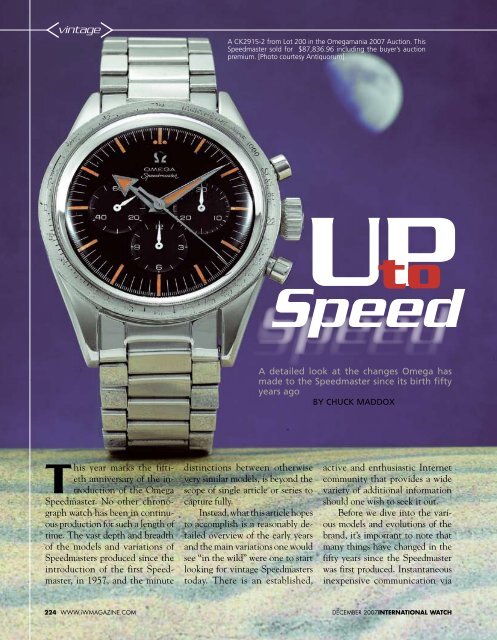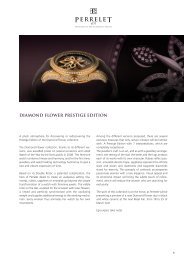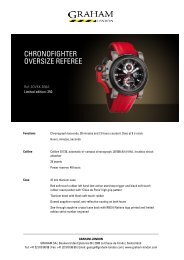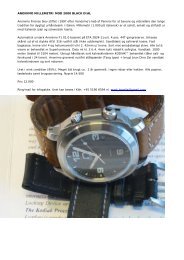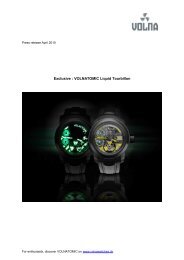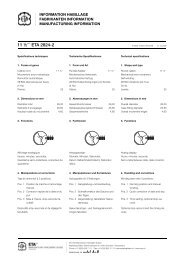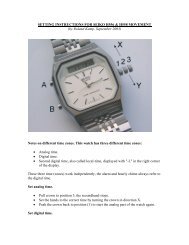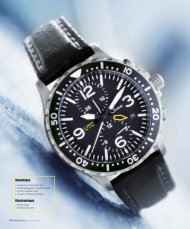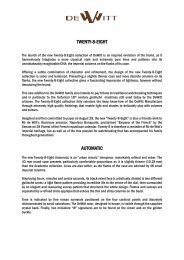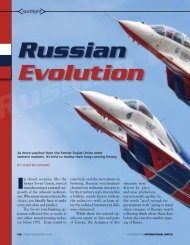vintage - Watchuseek, World's Most Visited Watch Forum Site
vintage - Watchuseek, World's Most Visited Watch Forum Site
vintage - Watchuseek, World's Most Visited Watch Forum Site
You also want an ePaper? Increase the reach of your titles
YUMPU automatically turns print PDFs into web optimized ePapers that Google loves.
.<br />
<strong>vintage</strong><br />
This year marks the fiftieth<br />
anniversary of the introduction<br />
of the Omega<br />
Speedmaster. No other chronograph<br />
watch has been in continuous<br />
production for such a length of<br />
time. The vast depth and breadth<br />
of the models and variations of<br />
Speedmasters produced since the<br />
introduction of the first Speedmaster,<br />
in 1957, and the minute<br />
224 www.iwMagazinE.CoM<br />
A CK2915-2 from Lot 200 in the Omegamania 2007 Auction. This<br />
Speedmaster sold for $87,836.96 including the buyer’s auction<br />
premium. [Photo courtesy Antiquorum].<br />
Speed<br />
Speed<br />
A detailed look at the changes Omega has<br />
made to the Speedmaster since its birth fifty<br />
years ago<br />
By ChuCk MAddOx<br />
distinctions between otherwise<br />
very similar models, is beyond the<br />
scope of single article or series to<br />
capture fully.<br />
Instead, what this article hopes<br />
to accomplish is a reasonably detailed<br />
overview of the early years<br />
and the main variations one would<br />
see “in the wild” were one to start<br />
looking for <strong>vintage</strong> Speedmasters<br />
today. There is an established,<br />
Upto<br />
active and enthusiastic Internet<br />
community that provides a wide<br />
variety of additional information<br />
should one wish to seek it out.<br />
Before we dive into the various<br />
models and evolutions of the<br />
brand, it’s important to note that<br />
many things have changed in the<br />
fifty years since the Speedmaster<br />
was first produced. Instantaneous<br />
inexpensive communication via<br />
DECEMBER 2007INTERNATIONAL WATCH
the Internet, electronic databases,<br />
modern inventory tracking, and<br />
the ease of recording, storing and<br />
accessing information differs vastly<br />
today from the late 1950s, when the<br />
Speedmaster was first produced.<br />
Changes were often made<br />
quickly, with little or no distinction<br />
being noted, and with little<br />
consideration that a couple of<br />
decades down the road collectors<br />
would have any interest as to<br />
when a hand was changed, or if<br />
the firm made a subtle difference<br />
in the shape of a letter on a dial, or<br />
why some watches would seem to<br />
have attributes of either the previous<br />
or successor models.<br />
The folks on the production<br />
line and the managers in their<br />
offices in the late 1950s likely<br />
weren’t considering the interest or<br />
the monies their products would<br />
be fetching in auctions today. Just<br />
as dinosaurs lived their lives with<br />
little regard for today’s paleontolo-<br />
INTERNATIONAL WATCHDECEMBER 2007<br />
gists, Swiss crafstmen in this epoch<br />
did their work without much<br />
concern for our ability to make<br />
sense of it today. They were more<br />
concerned with quality, meeting<br />
demand, remaining profitable and<br />
viable against the competition.<br />
As a result, the further one<br />
goes back into history, the more<br />
blurred the story gets.<br />
Origins<br />
The Speedmaster story begins<br />
with the CK2915, also known as<br />
“The original 1957 Speedmaster”<br />
and sometimes [inaccurately] as<br />
the “Broad Arrow.” Pierre Moinat,<br />
the creative director of Omega,<br />
developed the main idea for the<br />
design. Among his goals: a rugged,<br />
more waterproof chronograph<br />
with a large, easily read dial. The<br />
intended market was professionals<br />
and enthusiasts in the aviation, automotive<br />
and sporting fields, where<br />
ease of reading and usage would be<br />
Left: German Omega Catalog showing<br />
either a CK2915-3 or an early CK2998.<br />
Center: 1963 German Omega Catalog<br />
showing Omega’s intended market.<br />
Below: The catalog cover. All ads this<br />
page courtesy of www.old-omegas.com<br />
.<br />
of utmost utility. The design was<br />
entrusted to Claude Baillad, while<br />
Georges Hartmann crafted the first<br />
prototype.<br />
The CK2915 was produced<br />
in three different series from 1957<br />
through 1958, as officially denoted<br />
by the caseback designations:<br />
CK2915-1, CK2915-2, CK2915-3<br />
(which collectors often shortened<br />
to “dash one,” etc.). The similar<br />
elements in these three sub-models<br />
are a Tritium-marked dial with<br />
an applied metal Omega “Ω”<br />
logo, “OMEGA” in all-cap block<br />
type, “Speedmaster” in title-case<br />
script, spearpoint subdial hands, a<br />
straight needle chronograph second<br />
hand, “Speedmaster” in an<br />
arc between two case tool notches,<br />
the hippocampus chemically<br />
engraved two angle caseback, 4<br />
mm diameter pushers and 6 mm<br />
diameter crown.<br />
However, each of these models<br />
differed in the following ways:<br />
www.iwMagazinE.CoM 225
<strong>vintage</strong><br />
3 CK2915-1: Has natural colored<br />
stainless steel bezel embossed and<br />
inked with black painted text.<br />
The bezel black paint in the crevices<br />
of the embossed steel with<br />
“TACHYMÈTRE BASE 1000” is<br />
unique to this model. This model,<br />
along with the CK2915-2, has the<br />
so-called “broad arrow” hands,<br />
which are also known as “Balane,”<br />
with the arrow on the hour hand.<br />
3 CK2915-2: Transition midway<br />
from the black on natural steel<br />
bezel to the more common silver<br />
on black paint bezel. The “TA-<br />
CHYMÈTRE BASE 1000” printing<br />
remains through the CK2998-<br />
1 model.<br />
3<br />
CK2915-3: This is the transitional<br />
model to the CK2998. While a<br />
few early examples retain the Balane<br />
hands of the -1 and -2 models,<br />
many examples exist of this model<br />
226 www.iwMagazinE.CoM<br />
with the later CK2998 style hands,<br />
which are commonly known as<br />
“dauphine” or “alpha” hands. The<br />
rest of this model is essentially the<br />
same as the CK2915-2.<br />
The CK2915 model Speedmaster,<br />
because it was the first<br />
produced, is among the most avidly<br />
sought, and as a result it is<br />
exceedingly pricey to obtain, with<br />
the exception of the CK2915-3,<br />
which is typically found priced<br />
similarly to the CK2998 models,<br />
which it more closely resembles.<br />
Next generation<br />
Considering the notable and substantial<br />
changes made between the<br />
CK2915-1 and CK2915-3, Omega<br />
soon noted these distinctions with<br />
a new case reference number,<br />
CK2998. The CK2998 was made<br />
Left: The author’s CK2915-3.<br />
Note the “Base 1000” bezel. Many<br />
CK2915-3’s are configured like this<br />
with “alpha/dauphine” hands, even<br />
though they are CK2915 models.<br />
Below: A CK2998 with a lollipop<br />
second hand. (Photo Omega Museum,<br />
Bienne)<br />
in at least seven different case<br />
reference numbers, CK2998-1<br />
through 6, and also -62 as Omega<br />
started to transition to a new case<br />
reference standard in late 1962.<br />
I’ve been studying the Speedmasters<br />
since 1998 and I have yet<br />
to find any person or document<br />
that lays out all of the subtle distinctions<br />
between these models.<br />
Starting from the basic features of<br />
the CK2915-3, one of the first distinctions<br />
was the chronograph second<br />
hand which, while remaining<br />
needle-shaped, was painted white<br />
to stand out in poor light from the<br />
dial. In addition, the location of<br />
the “Speedmaster” engraved text<br />
on the caseback is moved from between<br />
two of the wrench notches<br />
on the caseback to an arc on the<br />
flat part of the caseback, in an arc<br />
over the Hippocampus.<br />
DECEMBER 2007INTERNATIONAL WATCH
<strong>vintage</strong><br />
Throughout the production<br />
run of the CK2998, the bezel<br />
would lose the “Base 1000” marking<br />
[to be replaced with numerals<br />
going up to 500], the subdial<br />
hands would migrate from their<br />
spearpoint shape to straight whitepainted<br />
stick hands (as seen on all<br />
Speedmasters produced since),<br />
the pusher size remains at 4 mm<br />
in diameter while the crown has<br />
grown in size to 7 mm.<br />
Also, some CK2998s were produced<br />
with a unique chronograph<br />
second hand with a “Lollipop” luminous<br />
circle located at the same<br />
height as the Omega logo on the<br />
dial. These “Lollipop” Speedmasters<br />
are very uncommon and fetch<br />
high prices when listed for sale.<br />
Later CK2998s adopted a new and<br />
different chronograph seconds<br />
hand, which would be used for<br />
several years. This new hand had<br />
a spearpoint luminous shape approximately<br />
over the Omega logo<br />
when the chronograph was reset<br />
at zero, as well as a “spearpoint”<br />
counterbalance as opposed to the<br />
228 www.iwMagazinE.CoM<br />
Left: 1964 Omega Catalog showing an ST 105.002 on left with a Seamaster<br />
300 ST 165.014 on the right. Above: 1963 German Omega<br />
Catalog showing a 105.003 on the right priced at 455 German Marks<br />
(about $115). Ad pictured courtesy www.old-omegas.com.<br />
original needle shaped hand.<br />
Because the CK2998s and a<br />
very select few 105.002’s have the<br />
unique Dauphine hands, these<br />
watches attract more interest and<br />
hence higher prices than later<br />
Speedmasters.<br />
This series of watches also has<br />
the distinction of being the model<br />
of Speedmaster that Wally Schirra<br />
wore during his Sigma 7 Mercury<br />
mission, making it the first Speedmaster<br />
to reach orbit. Later on,<br />
NASA would purchase Speedmasters<br />
for evaluation, testing and<br />
as a result of those tests make the<br />
Speedmaster the standard-issue<br />
Astronaut wristwatch<br />
Rare model<br />
Next up is the 105.002. By now<br />
the Speedmaster has moved away<br />
from many of the features that<br />
made the early Speedmasters<br />
unique and unlike the later models.<br />
Long gone were the Balane<br />
hands, silver bezel, the smaller<br />
crown and distinctive caseback<br />
marking of those early editions.<br />
<strong>Most</strong> of these changes were<br />
made to improve the usability<br />
of the Speedmaster: The earlier<br />
Balane hands covered up far too<br />
much of the dial and often subdials<br />
of the chronograph, diluting<br />
the watch’s ability to be used for<br />
one of it’s intended functions.<br />
The silver bezel was discarded<br />
because pilots and drivers<br />
were frequently in bright, sunny<br />
conditions and the chance the<br />
bezel could reflect the sun’s<br />
blinding glare into the wearer’s<br />
eyes was very real. The 105.002<br />
started off as the first Speedmaster<br />
to be brought into line with<br />
Omega’s new unified case-referencing<br />
system.<br />
Balane hands, as well as newly<br />
adopted white painted stick hands,<br />
were both produced for this model.<br />
The dauphine hands, which<br />
were unpainted save for the Tritium<br />
luminous inserts, were often<br />
difficult to read in certain lighting<br />
conditions. So Omega switched<br />
to white stick hands starting with<br />
some late 105.002s.<br />
DECEMBER 2007INTERNATIONAL WATCH
The 105.002 was only in<br />
production for a few short<br />
months in 1962 and possibly<br />
1963 before Omega formalized<br />
the change to white stick hands<br />
for the 105.003 model. So this<br />
transition model between the<br />
CK2998 and the 105.003 was<br />
not produced in high numbers,<br />
is exceedingly rare, and hence<br />
commands formidable prices<br />
when offered.<br />
1963: Splitting the<br />
Speedmaster<br />
With the late production<br />
105.002s, most of the unique<br />
differences between the original<br />
Speedmaster and the modern<br />
Speedmaster had been evolved<br />
The author’s 105.003-65<br />
is often called “The Quiet<br />
Speedmaster.”<br />
Above,top:1967 Omega catalog with 105.003, a Seamaster and a “no-name” model. Below that, a rare French Omega catalog page<br />
from 1964 or 1965 showing 105.003 and 105.012 side-by-side. This is the only catalog I’ve ever seen that has both models side-by-side.<br />
Price for each model was 480 French francs, or roughly $100 in 1964-5 U.S. dollars. (Top ad courtesy of www.old-omegas.com; lower<br />
ad from the author’s archives.)<br />
out of the Speedmaster line.<br />
The 105.003 incorporates most<br />
of these changes, though a few<br />
differences remain. The “quiet”<br />
Speedmaster, as the 105.003 is<br />
often called, has the most plain<br />
and elegant appearance when<br />
compared to models produced<br />
prior or after its production.<br />
This ‘003 retains the plain<br />
lugs of the early model Speedmasters,<br />
the applied metal Omega<br />
logo, the now familiar black bezel<br />
with silver numerals, adds 5 mm<br />
diameter pushers (which would<br />
be the size used henceforth), but<br />
does not have “Professional” on<br />
the dial, nor the twisted lugs of<br />
a sister model introduced in the<br />
same time frame, the 105.012.<br />
The 105.012 differs from the<br />
105.003, at least initially, in the<br />
shape and style of its case. While<br />
it and all previous Speedmasters<br />
shared the same plain-lugged case<br />
with no crown or pusher guards<br />
and a lug width of 19 mm, the<br />
new 105.012 has an asymmetrical<br />
case with a 20 mm lug width,<br />
added protection for the crown<br />
and pushers and a sculpted twist<br />
to the lugs.<br />
In French, this style is called<br />
Bombé and adds a layer of complication<br />
to the look of the Speedmaster.<br />
Until 1965, the other<br />
features and look of the 105.012<br />
are identical to the 105.003. They<br />
share the same bezel, dial, hands<br />
and caseback—except for the case<br />
INTERNATIONAL WATCHDECEMBER 2007 www.iwMagazinE.CoM 229
<strong>vintage</strong><br />
This 1963 UK Omega catalog<br />
shows an ST 105002/2998 priced<br />
at £53.10, which would convert to<br />
$150 in 1963.<br />
reference number engraved on the<br />
inside caseback.<br />
After Wally Schirra and Gordon<br />
Cooper wore the Speedmaster<br />
on their Mercury missions (Cooper<br />
wore both a Speedmaster and<br />
a Bulova Accutron Astronaut,<br />
because his mission lasted more<br />
than 24 hours), NASA decided<br />
that the utility of having its astronauts<br />
equipped with a standardized<br />
wrist chronograph was beneficial.<br />
It began testing candidate<br />
chronographs.<br />
During the break between<br />
Mercury and Gemini, NASA tested<br />
chronographs for astronaut use.<br />
The eventual winner of the testing<br />
was the Speedmaster.<br />
The majority of Speedmasters<br />
NASA acquired were 105.012s,<br />
but a number of 105.003s (like Ed<br />
White’s) and—later—145.012s<br />
were obtained. The Omega community<br />
has not been able to assemble<br />
a full list of the chronographs obtained<br />
by NASA, but a partial list<br />
has been assembled by Omega and<br />
is in collectors’ hands.<br />
A few months after Ed White’s<br />
Gemini 4 spacewalk, NASA photos<br />
230 www.iwMagazinE.CoM<br />
of the EVA were published in National<br />
Geographic. Omega has said<br />
that this was the first indication they<br />
had that NASA had been issuing<br />
the Speedmaster to astronauts.<br />
To signify this, Omega decided<br />
to rename the model the<br />
Omega Speedmaster Professional.<br />
Soon, in the fall of 1965, 105.012s<br />
started being produced with dials<br />
bearing “PROFESSIONAL” in all<br />
caps below the script “Speedmaster”<br />
on the dial. The 105.003 was<br />
superseded by a new case reference<br />
(the 145.003) and the 105.012<br />
was soon to be replaced by a new<br />
case reference (the 145.012).<br />
Mysteries<br />
There is a bit of uncertainty about<br />
the sequence of events with all<br />
four of these case reference numbers.<br />
We know that the 105.003<br />
and 105.012 were produced simultaneously,<br />
and that the 105.003<br />
was discontinued in favor of the<br />
145.003 before the end of 1965.<br />
It seems that the 105.012 was in<br />
production with “Pro” dials at<br />
least through the end of 1965 and<br />
perhaps into 1966.<br />
There is also uncertainty as to<br />
when Omega started the practice<br />
of printing “PROFESSIONAL”<br />
on the dial. More than a couple<br />
105.012-63s have shown up for<br />
sale on the Web with “PROFES-<br />
SIONAL” dials that appear to be<br />
correct, with aged luminosity that<br />
matches the aging of the hands.<br />
Omega swears that the Pro dials<br />
post-date the National Geographic<br />
pictorial, but these watches pose<br />
an interesting mystery.<br />
Could these be watches that<br />
had their dials swapped far enough<br />
after original production to have<br />
been replaced with a later dial,<br />
but early enough so that the aging<br />
matches? Or is Omega mistaken<br />
about exactly when the Pro dials<br />
started appearing on 105.012s?<br />
In summary, originally,<br />
105.003’s all have dials without<br />
“PROFESSIONAL,” and the<br />
plain 19 mm lugged case. The<br />
105.012 can have either dial and<br />
the twisted lug 20 mm asymmetrical<br />
case, but one should scrutinize<br />
the serial number and year of production<br />
on the caseback carefully<br />
when considering the purchase of<br />
DECEMBER 2007INTERNATIONAL WATCH
Omega was quick to capitalize on its<br />
NASA-Speedmaster connection. Courtesy<br />
Steve Waddington from his site, www.oldomegas.com.<br />
the 105.012 model: If the 105.012<br />
you’re looking at is a -63 or -64<br />
with a non Professional dial, it’s<br />
probably fine, and with a 105.012-<br />
65 either dial is correct, but a Pro<br />
dial on a 1964 or earlier model<br />
should be viewed with caution.<br />
The Replacements<br />
In 1965 Omega decided again to<br />
change the case reference number<br />
of the Speedmaster line, which<br />
now consisted of two models, the<br />
plain and bombé lug versions. The<br />
main difference between the outgoing<br />
105.003 and 105.012 models<br />
and their 145.003 and 145.012<br />
replacements is the shape of the<br />
caseback. The earlier models had<br />
a “two-step” slope to the angled<br />
part of the caseback, while the<br />
new models had a single angle.<br />
The 145.012s uniformly have<br />
Professional dials, but about halfway<br />
through the production run<br />
Omega changed the chronograph<br />
seconds-hand from a “spear-<br />
Far left: 1971 Omega ad showing the Mark II Professional which we’ll discuss<br />
in the next segment of this series. Ad at left shows a 1969 Omega 105.012 with<br />
pre-Professional-dialed 105.012 with a listed price of £66 or $160 1969 U.S.<br />
dollars. Both are courtesy of Steve Waddington’s www.old-omegas.com site.<br />
The author’s 145.012-67.<br />
The -68 model is the last<br />
of the c.321-movement<br />
Speedmasters.<br />
point”- shaped counter-balance to<br />
a counter-balance with slab sides.<br />
Save for the diamond-shaped luminous<br />
element near the top of<br />
the chronograph seconds hand,<br />
the entire hand would have a triangular<br />
shape. Other than that,<br />
production of the 145.012 would<br />
proceed unchanged to the last<br />
half of October 1968.<br />
The 145.003, on the other<br />
hand, is a rare bird.<br />
How rare? I’ve been collecting<br />
Speedmasters actively for nearly<br />
nine years and I’ve seen exactly<br />
two of them. For many years the<br />
145.003 was considered a myth,<br />
like the Loch Ness monster, with<br />
Omega saying they made them.<br />
With no pictures or other sightings,<br />
it was difficult to confirm<br />
their existence. However, an Italian<br />
collector has posted pictures of<br />
an example that a fellow Italian<br />
collector owns.<br />
To the Moon<br />
Over the years there has been much<br />
discussion and even debate in the<br />
Omega collecting community as to<br />
which model Speedmasters actually<br />
made it to the moon. The answer is<br />
an open one. We can confirm that<br />
at least three different Speedmaster<br />
case references made it to the moon<br />
(along with a Waltham Chronograph).<br />
While we can exclude any<br />
models made after 1972, we can’t<br />
confirm or repudiate other models<br />
made before then. The models we<br />
can confirm are 105.003, 105.012<br />
and 145.012.<br />
Next edition in this series: Speedmasters<br />
of the 1970s. Chuck Maddox<br />
hosts a collector’s blog at www.chuckmaddoxwatch.blogspot.com.<br />
C<br />
INTERNATIONAL WATCHDECEMBER 2007 www.iwMagazinE.CoM 231


